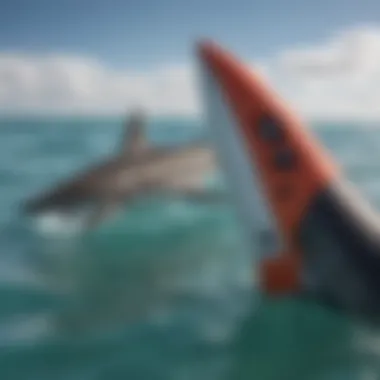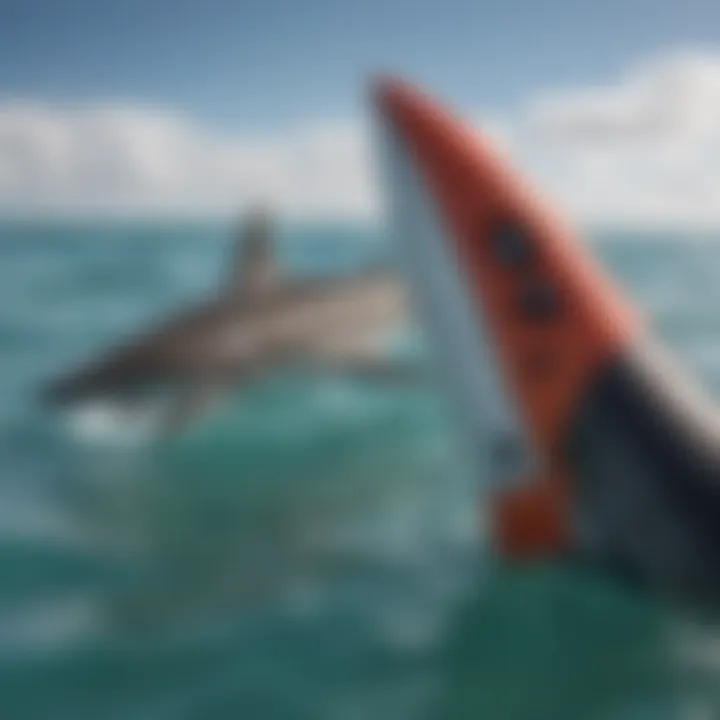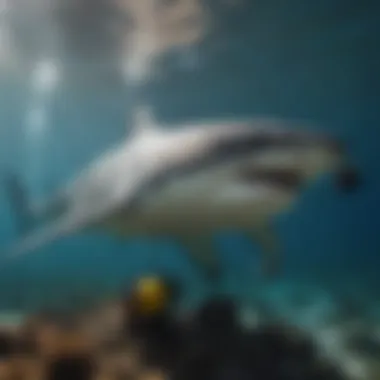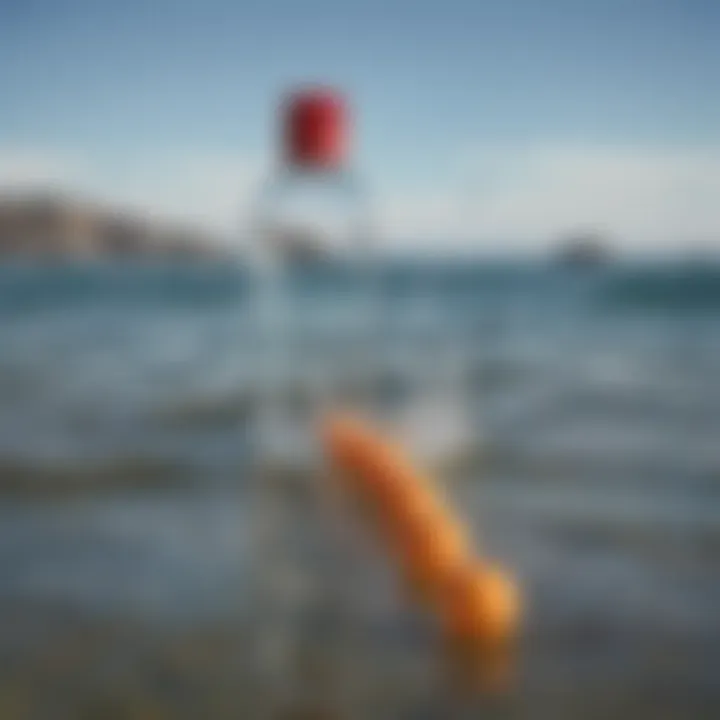Exploring Shark Repellents: Methods and Safety Insights


Intro
Shark attacks, while quite rare, instill a sense of fear among those who love water sports. As surfers, paddleboarders, and kitesurfers flock to the ocean, the safety concerns about these magnificent creatures lurk beneath the surface of enjoyment. This article aims to illuminate the realm of shark repellents, exploring various techniques employed to dissuade sharks while also addressing their effectiveness and safety.
Understanding the methods available helps water sports enthusiasts make informed choices. Whether one gravitates towards chemical repellents, electronic devices, or natural deterrents, it’s crucial to evaluate both the impact on personal safety and the larger implications for marine ecosystems. Together with an assortment of anecdotes and scientific insights, we strive to provide a comprehensive guide that balances thrill-seeking with responsibility.
Gear not only protects the user but also compliments the enjoyment of the sport. Thus, equipping oneself with the right tools and knowledge becomes pivotal. We will delve into gear essentials next, shedding light on top picks and maintenance advice aimed explicitly at the prudent aficionado.
Intro to Shark Repellents
Shark repellents are increasingly becoming a key focus for many water activities enthusiasts. The importance of understanding these repellents lies not just in ensuring the safety of surfers, paddleboarders, and kitesurfers, but also in grasping their broader implications on marine ecosystems. As more individuals engage with the ocean, the intersection of safety technology and ecological responsibility grows ever significant. By delving into this realm, we learn about the potential benefits, the challenges posed, and the considerations that must be taken into account to harmonize human activities with the oceanic environment.
Definition and Purpose
At its core, a shark repellent is anything that aims to deter sharks from approaching swimmers or watercraft. This may encompass various techniques ranging from chemicals to intricate electronic devices. Ideally, these tools serve to provide a sense of security while minimizing the risks faced by those who frequent aquatic locations. Furthermore, the parameters of effectiveness can vary immensely, making it crucial to ascertain how well different methods actually work in real-world settings. Some solutions target the sharks’ sensitive sensory systems, while others aim to create physical barriers or environmental manipulation that shifts shark behavior. Understanding the nuanced mechanisms behind these techniques facilitates informed decision-making for water sports enthusiasts seeking to safeguard themselves.
History of Shark Repellents
The journey of shark repellents is rich, dating back several decades, if not longer. Evidence suggests early attempts to ward off these predators relied heavily on natural deterrents and rudimentary methods. Fishermen, equipped with braided wires and other such tactics, were among the first to figure out ways to keep their catches safe.
As time progressed, so too did the development of technology. The 20th century saw a rush towards scientific exploration, with varied experiments to find effective methods that could be used widely. Powerful electric fields and chemical formulations became the talk of the town, piquing the interest of researchers and developers alike.
Today, repellents can be found in many shapes and forms, firmly embedded in the context of surfing culture. With advancements in materials and technology, they are evolving into more sophisticated iterations that promise better safety for users. Understanding this historical context not only provides insight into effective solutions but also illustrates humanity's ongoing relationship and sometimes cautious partnership with the ocean's inhabitants.
Types of Shark Repellant Technologies
In the quest for safe aquatic experiences, understanding the different types of shark repellent technologies becomes essential. These methods are designed not just to protect water sports enthusiasts, but also to foster a more harmonious interaction between humans and the ocean. Each technology has its own nuances, advantages, and limitations. This section will explore chemical, electronic, and natural deterrents, shedding light on their workings and relevance in the marine ecosystem.
Chemical Repellents
Mechanism of Action
Chemical repellents function similarly to a well-placed scare tactic, deploying substances that either disrupt a shark's senses or alter its hunting instincts. The efficacy often lies in the active ingredients used, which can range from naturally derived compounds to synthetic formulations. For example, some chemical repellents emit odors that are unpleasant to sharks, effectively sending them packing. This type of repellent is favored by many due to its ease of use; water enthusiasts can simply apply a spray or lotion before heading into the water.
Yet, there’s a catch. The actual effectiveness can be debated, and the response of different shark species might vary significantly. A key characteristic is that they may provide a false sense of security if users haven't conducted proper research into their specific efficacy against particular species.
Effectiveness in Varying Conditions
Effectiveness in varying conditions is another significant consideration. The performance of chemical repellents can be influenced by factors like water temperature, salinity, and even turbidity. Some studies have shown that specific formulations excel in clear waters but falter in murky environments, where sharks’ senses are engaged differently. This paradox makes it crucial for users to thoroughly evaluate the conditions they'll encounter.
For instance, using certain repellents in tropical waters might yield favorable results, while the same repellent could be useless in colder, less salty waters. Additionally, it's worth noting that chemical repellents might not deter larger species, which could lead to some disappointing outcomes if expectations aren't aligned with reality.
Electronic Devices
Understanding Electromagnetic Fields
Electronic devices harness the concept of electromagnetic fields (EMFs) to deter sharks. These devices often produce pulses that are believed to interfere with the electrical signals in a shark's body, effectively confusing their natural navigation and hunting capabilities. The fundamentals behind this technology are intriguing, as the sharks, exacerbated by the pulses, tend to swim away from these disturbances.
A standout feature is their potential for longer-term effectiveness, as once set up correctly, there's little upkeep involved. It’s akin to having a motion sensor for unwanted guests, but in a much more ocean-centric layout. However, being effective relies heavily on the correct positioning and the device's proximity to the potential shark encounter.
User Experiences and Case Studies
User experiences and real-life case studies provide valuable insights into the efficacy of electronic devices. Many water sports enthusiasts have shared varied accounts, from confident praises of safety during long surfing sessions, to mixed feelings stemming from perceived inadequacies in high-density shark habitats.
With detailed reports collected from numerous users, the community's narrative becomes richer. Some found peace of mind using these gadgets, while others faced letdowns when devices failed as expected. Notably, collaboration between users has birthed an invaluable resource pool of case studies, aiding others in choosing the right technology and usage practices.


Natural Deterrents
Biological Affects on Sharks
Natural deterrents lean more towards ecological balance rather than blatant confrontation. Certain biological substances, such as specific oils or fish ingredients, can elicit an aversive response from sharks. The unique composition of these materials serves as a way to disrupt normal behavior patterns by affecting their olfactory responses.
A key advantage is inherent: these are typically less harmful to the surrounding ecosystem. For instance, sharks, with their unique biology, can be influenced by the presence of certain algae or even by other predator scents, steering them away from human activities. However, the natural variability reigns supreme here, with effectiveness fluctuating based on conditions and species.
Environmental Considerations
Environmental considerations tie these natural deterrents back to the larger ecosystem. Employing bio-based repellents encourages an understanding of marine life dynamics and favors solutions that coexist harmoniously with nature. These considerations become paramount when evaluating their long-term feasibility as they tend to enhance biodiversity rather than harm it.
It's essential to recognize that while natural methods may emphasize sustainability, their effectiveness could wane with alterations in marine environments caused by human activity. Practicing responsible ocean use becomes a necessary precondition for these deterrents to work as intended. That being said, the upside is clear: encouraging the natural behavior of sharks can go a long way in preserving ocean health while still promoting water sports activities.
Evaluating Effectiveness
Understanding the effectiveness of shark repellents is crucial for both safety and innovation in this field. A deep dive into the effectiveness helps direct future research, refine existing technologies, and ensure that users are equipped with reliable methods to deter sharks. Considering the specific contexts in which these repellents are used—like different water sports and environmental conditions—will also inform best practices for users. Ultimately, assessing effectiveness builds confidence for enthusiasts, allowing them to enjoy their aquatic activities with greater peace of mind.
Scientific Studies and Results
Scientific backing is what gives weight to claims about any product. When it comes to shark repellents, there are two key types of studies: field studies and laboratory experiments.
Field Studies
Field studies are the real deal. They take place in the natural habitat of sharks, providing firsthand evidence of how effective various repellents are in real-world conditions. One of the standout features of field studies is their ability to capture the complex interactions within marine environments that a lab simply cannot replicate. For this reason, these studies are often seen as a beneficial choice for evaluating effectiveness.
Field studies often involve tracking the behavior of sharks in response to certain repellent measures. This is a unique feature that allows researchers to gather data over extended periods, revealing patterns that are pivotal to understanding shark behavior. However, the downside is hetfield conditions can vary greatly—these studies might indicate effectiveness in one region but fail elsewhere due to differing environmental factors.
Laboratory Experiments
On the contrary, laboratory experiments create controlled environments that isolate variables, making them another valuable method of assessment. The key characteristic of laboratory experiments is their precision. They allow scientists to test specific variables, such as concentration levels in chemical repellents, without the unpredictable influences of nature.
One unique feature is that these experiments can simulate various scenarios—from different water temperatures to diverse shark species—providing a broad spectrum of data. However, while lab results may be highly accurate, they sometimes lack generalizability. What works in a lab may not always hold true in the dynamic ocean environment, making it essential to use them in tandem with field studies.
User Testimonials and Anecdotes
Real-life experiences provide crucial insight into the functioning of shark repellents. Testimonials and stories from individuals who have used these products can supplement scientific evidence, giving a fuller picture of effectiveness.
Positive Experiences
Many users report positive experiences with particular shark repellent products. These anecdotes often highlight an increase in confidence while engaging in water sports. A user might say, "Since I started using a certain electronic device, I’ve felt much safer, particularly during dawn and dusk when sharks are more prevalent." The emotional aspect here isn’t to be dismissed —the peace of mind is a significant win, and it often becomes a reason to recommend such products to others.
This shared positivity becomes a catalyst for wider acceptance of shark repellents among new users. However, it’s important to ensure that these reports are balanced; emotional experiences alone do not replace scientific evaluation.
Limitations and Failures
While positive experiences are uplifting, it’s equally essential to acknowledge the limitations and failures associated with shark repellents. Not every product works for everyone, and some stories reveal confusing results that hinder confidence. A common narrative is when a surfer feels reassured by a repellent, but then encounters a shark regardless. This can lead to skepticism about the efficacy of the device.
The unique feature of these limitations is that they often encourage users to research and engage more deeply with the products. They raise questions about what works, under what circumstances, and open up discussions on potential improvements. The challenge here is ensuring that this information is communicated effectively, emphasizing that while some products offer value, no technique is foolproof.
In summary, evaluating the effectiveness of shark repellents requires a balanced approach that synthesizes scientific research with user experiences. Both the positive and negative narratives form a crucial tapestry of understanding in the broader context of shark repellent technology.
This leads us towards a more informed future—both for product development and for those who enjoy the thrill of water sports.
Safety Considerations
In the world of shark repellents, discussing safety considerations is paramount. The interactions between these methods and the marine environment can have far-reaching consequences. It's not just about keeping human activities safe; it’s equally about preserving the ecological balance of our oceans. Understanding these aspects ensures that watersport enthusiasts can enjoy their activities without jeopardizing marine life.


Impact on Marine Life
Alterations in Behaviors
A crucial feature of alterations in behaviors is how marine life reacts to new stimuli introduced by shark repellents. These repellents can change the way sharks and other marine creatures behave, often leading to avoidance of specific areas where these repellents are in use. It’s a natural instinct; much like humans avoiding places they been warned about. For instance, when certain chemical repellents are deployed, sharks might steer clear, affecting their hunting patterns and social interactions. This behavior modification is significant, as it can lead to unexpected consequences in marine ecosystems. Yet, this alteration in behavior can be beneficial. By steering sharks away from crowded areas, we may reduce the risk of unwanted encounters, making it a popular choice for many involved in water sports. However, tweaking natural behaviors is always a double-edged sword, with potential disadvantages.
Effects on Biodiversity
Another aspect worth examining is the effects on biodiversity. The introduction of shark repellents can disrupt the natural dynamics within marine communities. When certain species are deterred, this can create gaps in the ecosystem. For instance, a decrease in predators like sharks may lead to an overabundance of their prey species, ultimately shifting the balance of marine life. Such disruptions can lead to less diversity in marine habitats. Nevertheless, understanding these effects is a vital part of our discussion. The unique features of these impacts inform us of the fragility of ocean life, leading to an awareness that can foster better solutions. Reconsidering our approach to using these repellents is crucial to maintain biodiversity while still ensuring human safety.
Human Safety and Regulations
Regulatory Frameworks
The regulatory frameworks surrounding shark repellents play an essential role in shaping how these technologies are developed and used. Various nations have different laws that govern the use of chemicals and devices in oceanic waters. Keeping watersport enthusiasts safe while ensuring that the marine environment isn’t harmed is a tightrope walk for regulators. The beauty of these frameworks is that they often require thorough evaluations before any product can be marketed for public use. This diligence means that harmful effects are less likely to be overlooked. However, strict regulations can sometimes stifle innovation, making it crucial to find a balance that allows for advancements while still protecting both humans and marine life.
Best Practices for Users
User adherence to best practices is vital in ensuring that shark repellents are used safely and responsibly. These recommendations vary widely, from proper usage techniques to understanding the environmental implications. One best practice can include thoroughly researching any product's impact on marine wildlife before use, ensuring the watersport enthusiast knows what shifts they might cause in the ecosystem. Such diligence benefits both the user and the broader community. On the flip side, if best practices are ignored, the risks multiply. This can lead not only to unsuccessful deterrence but potentially harmful effects on local marine life. Educating users is crucial, as each person plays a part in maintaining the delicate balance between enjoying the ocean and preserving its wonders.
Shark Repellents in Watersports
The intersection of shark repellents and watersports is a crucial area of focus for anyone who enjoys activities like surfing, paddleboarding, or kitesurfing. This significance stems from the growing concerns over marine safety as more enthusiasts take to the water. Shark repellents not only aim to protect these users but also enhance their overall experience.
When practitioners of these sports are confident about their safety, it drastically alters their mindset and lets them concentrate on enjoying the thrill of the moment. The advancements in technologies — whether chemical, electronic, or natural — can encourage more people to engage in and continue with their favorite water activities.
The psychological comfort provided by these repellents cannot be overlooked. Knowing there are methods in place to deter sharks contributes positively to the mental state of surfers, paddleboarders, and kitesurfers alike.
Usage among Surfers
Adopting New Technologies
Surfers have increasingly turned to new technologies in shark repellent solutions. This shift represents an important giving of reassurance. The specificity of modern devices, like electronic repellents that utilize electromagnetic fields to create discomfort for sharks, is of paramount importance.
These modern methods stand out due to their non-invasive nature; they do not harm marine life. The widespread adoption of such technologies is increasingly evident, particularly as surfers report increased peace of mind when hitting the waves. One standout is the Shark Shield, which is designed to deter sharks while having minimal impact on aquatic ecosystems.
However, some surfers may still feel skepticism. What if the technology fails? This lingering question about reliability illustrates a unique challenge facing these innovations.
Psychological Benefits
Addressing mental well-being is another side of the story. The psychological benefits of using shark repellents are often overlooked, but they hold immense value. When surfers use these tools, they tend to report feeling more at ease, allowing them to fully immerse themselves in their passion without the omnipresent fear of unexpected encounters.
The reassuring nature of these devices can indeed be a game-changer. Surfers assert that feeling secure encourages longer sessions and bolsters overall enjoyment. Yet, this aspect may ebb and flow based on individual experiences and mindsets, as some may still grapple with anxiety regardless of the measures employed.
Paddleboarding and Kitesurfing Perspectives
Challenges and Considerations
Paddleboarders and kitesurfers face a unique set of challenges when it comes to shark safety. The primary consideration is the difference in mobility and proximity to the water surface. Paddleboards tend to remain relatively close to the water, which could increase the likelihood of shark interactions. Therefore, balancing the need for protection without over-relying on repellents is a tricky task.
The expansive range of these activities means that not all tools work universally. Some paddlers might find that repellents designed for surfers don’t yield the same results for paddleboarding, as the dynamics change drastically. This issue brings forth the key realization; solutions must cater to the specific challenges posed by each sport.
Community Insights
Community insights serve as a backbone for any conversation about shark repellents in these watersports. Feedback from fellow enthusiasts often holds sway in decision-making processes regarding repellent usage. Forums, social media groups, and local meet-ups provide invaluable first-hand accounts.
Surfers and paddleboarders share strategies, past encounters, and which technologies worked or fell short. This communal brainstorming forms a science in its own right, as collective experience contributes to a more informed choice about which repellents to trust.


In a nutshell, the exchange of knowledge and stories within communities lays the groundwork for more widely accepted practices regarding the use of shark repellents. It prompts discussions, cultivates support networks, and paves the way for innovation. These insights emphasize the necessity of shared understanding within the field, effectively amplifying the voices of watersport front-liners.
In summary, understanding the role of shark repellents in watersports is vital not just for safety, but for fostering a thriving community of enthusiasts.
Future Directions in Shark Repellant Research
Innovation in shark repellents plays a vital role in ensuring the safety of both aquatic enthusiasts and the delicate marine ecosystem. As concerns about shark encounters grow, advancements in repellent techniques are essential. The future of shark repellent research is about striking a balance between effective shark deterrence and the preservation of ocean health. Here, we explore anticipated innovations and sustainable practices that stand to shape this intriguing field.
Innovations on the Horizon
Emerging Technologies
Emerging technologies, such as electromagnetic field generators, are gaining traction as cutting-edge solutions in shark deterrents. These devices utilize electromagnetic pulses to create a disruption within the water, potentially disorienting sharks or steering them away. Their key characteristic is their non-invasive nature, which makes them more appealing to users who prioritize both safety and marine conservation.
One unique feature of these technologies is their adjustable intensity settings, allowing users to fine-tune the level of repellent effect based on specific conditions or environments. This flexibility presents a significant advantage, particularly in varied aquatic settings. However, such technology doesn't come without challenges. High costs and the need for charging or maintenance could limit their accessibility to the average water sports enthusiast.
Interdisciplinary Approaches
Combining marine biology with technology and engineering, interdisciplinary approaches can lead to innovative shark repellent solutions. Collaboration among marine scientists, engineers and conservationists could foster developments in biodegradable shark deterrents that are environmentally friendly.
A standout characteristic of these approaches is their holistic nature; they consider not only human safety, but also the ecological impact of the solutions. This comprehensive viewpoint helps address concerns about the long-term effects of repellents on marine species. One potential disadvantage is the requirement of various expertise and resources for effective development, which may prove challenging in the interdisciplinary collaboration process.
Sustainable Practices
Balancing Human Activity and Ocean Health
Addressing the needs of water sports enthusiasts while maintaining the balance of the ocean environment is crucial. Practices aimed at minimizing disturbances caused by human activities on marine life can significantly contribute to this balance. Research shows that effective shark repellent methods can coexist with conservation goals, allowing for safer water sports while protecting diverse aquatic ecosystems.
The unique aspect of these practices is their focus on ecosystem resilience—ensuring that marine life can thrive while humans engage in recreational activities. Balancing these can pave the way for sustainable human-ocean interactions. One potential disadvantage is the risk of resistance from watersport enthusiasts who may prioritize convenience over ecological considerations.
Community Outcomes
Engaging local communities in shark repellent research fosters a sense of responsibility toward marine conservation. Local knowledge and practices can contribute valuable insights into the behaviors of sharks and their habitats, aiding the development of effective repellent strategies.
A pivotal characteristic of community involvement is its potential to build stronger trust and collaboration between researchers, local fishermen, and water sports enthusiasts. This engagement can also lead to educational initiatives that inform users about sustainable practices. However, one challenge is ensuring that community-based solutions remain science-driven, which might require additional training or resources for participants.
Epilogue and Recommendations
The exploration of shark repellents is a complex yet important topic that spans various dimensions of marine safety, environmental concern, and human recreation. This section serves as a capstone to the findings, shedding light on the effectiveness, ecological implications, and sensible use of these deterrents. Understanding the nuances of this subject helps not only in protecting individuals who engage in water sports but also in fostering a respectful relationship with marine life.
Summary of Key Findings
From the studies reviewed, it is clear that no single approach to shark repelling is foolproof. Instead, effectiveness tends to vary based on the type of technology used, local conditions, and even the individual user's behavior. Chemical repellents, while sometimes effective, raise alarms regarding their environmental impact. Electronic devices have shown promise but require further research to establish long-term efficacy across different species. Natural deterrents emerged as a more ecologically friendly alternative, yet their effectiveness can fluctuate based on specific marine contexts.
Guidance for Watersport Enthusiasts
Responsible Usage
Responsible usage of shark repellents is paramount for anyone who frequently finds themselves in the ocean. This concept encapsulates not just the application of a repellent device, but a broader commitment to marine conservation and safety. A key characteristic of responsible usage is education; understanding both how to use these devices properly and their potential ramifications on marine ecosystems is essential. Not all products are created equal, and it’s vital for users to become acquainted with the options readily available.
By choosing responsibly designed products that minimize harm to the environment, water sports enthusiasts help to ensure that marine life is protected while still enjoying their sport. One unique feature of responsible usage is the emphasis on best practices, which includes not only utilizing repellents effectively but also staying informed about current regulations governing their use. The advantages of responsible usage include not only safety for the individual but also protection for the broader marine environment. However, it can pose a challenge as stringent regulation often limits product accessibility.
Community Engagement
The importance of community engagement cannot be overstated within the larger context of shark repellent usage. Engaging with local water sports communities fosters a collaborative approach to sharing knowledge and improving safety. This characteristic of community engagement extends beyond just the use of repellents—it taps into the ethos of supporting sustainable practices in water sports.
Communities can serve as platforms where experiences, successes, and failures are shared, facilitating a collective learning process. Such collaborative efforts can lead to the development of innovative strategies for minimizing human-shark interactions effectively. One unique feature of community engagement is its potential for collective advocacy; when many voices unite, they can influence regulation and broader societal attitudes towards marine preservation.
Ultimately, the advantages of community engagement include a greater pool of shared resources and knowledge, yet it may also mean dealing with diverse opinions on effective practices. Navigating these differences can be a challenge, but it is through discourse that best practices will likely emerge.
In summary, the future of shark repellents lies not just in technological advancements, but in the collective responsibility of individuals, communities, and regulatory bodies working together for safer and sustainable ocean interactions.
As this article concludes, the onus is now on enthusiasts to navigate these waters responsibly and thoughtfully.



